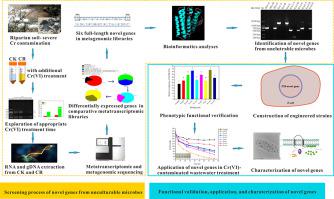Science of the Total Environment ( IF 9.8 ) Pub Date : 2020-06-25 , DOI: 10.1016/j.scitotenv.2020.140435 Yaxin Pei 1 , Chen Tao 2 , Zhenmin Ling 1 , Zhengsheng Yu 3 , Jing Ji 4 , Aman Khan 4 , Tursunay Mamtimin 5 , Pu Liu 6 , Xiangkai Li 1

|
Microbial remediation is a promising method to treat Cr(VI) in industrial wastewater. The remediation efficiency and stress-resistance ability of Cr(VI) remediation genes in microbes are the limiting factors for their application in industrial wastewater treatment. To screen novel highly efficient Cr(VI) remediation genes, comparative metatranscriptomic and metagenomic analyses were performed on long-term Cr(VI)-contaminated riparian soil with/without additional Cr(VI) treatment. The most suitable Cr(VI) treatment time was determined to be 30 min according to the high quality RNA yield and fold changes in gene expression. Six novel genes, which had complete open reading frames (ORFs) in metagenomic libraries, were identified from unculturable microbes. In the phenotypic functional assay, all novel genes enhanced the Cr(VI) resistance/reduction ability of E. coli. In the industrial wastewater treatment, E-mcr and E-gsr presented at least 50% Cr(VI) removal efficiencies in the presence of 200–600 μM of Cr(VI), without a decrease in efficiency over 17 days. The stress resistance assay showed that gsr increased the growth rate of E. coli by at least 30% under different extreme conditions, and thus, gsr was identified as a general stress-response gene. In the Cr valence distribution assay, E-mcr presented ~40 μM higher extracellular Cr (III) compared to E-yieF. Additionally, transmission electron microscopy (TEM) of E-mcr showed bulk black agglomerates on the cell surface. Thus, mcr was identified as a membrane chromate reductase gene. This research provides a new idea for studying novel highly efficient contaminant remediation genes from unculturable microbes.
中文翻译:

通过比较元转录组学和宏基因组学,探索新的Cr(VI)修复基因来处理受Cr(VI)污染的工业废水。
微生物修复是一种用于处理工业废水中六价铬的有前途的方法。微生物中Cr(VI)修复基因的修复效率和抗逆能力是其在工业废水处理中应用的限制因素。为了筛选新型高效的Cr(VI)修复基因,对长期受Cr(VI)污染的河岸土壤进行了比较转录组学和宏基因组学分析,有/无其他Cr(VI)处理。根据高质量的RNA产量和基因表达的倍数变化,确定最合适的Cr(VI)处理时间为30分钟。从无法培养的微生物中鉴定出六个基因,它们在宏基因组学文库中具有完整的开放阅读框(ORF)。在表型功能分析中,大肠杆菌。在工业废水处理中,当存在200–600μMCr(VI)时,E- mcr和E- gsr表现出至少50%的Cr(VI)去除效率,但在17天之内效率没有下降。抗逆性试验表明,在不同的极端条件下,gsr使大肠杆菌的生长速度至少提高了30%,因此gsr被鉴定为一般的胁迫反应基因。在Cr价分布分析中,与E- yieF相比,E- mcr的胞外Cr(III)高约40μM。此外,EMCR的透射电子显微镜(TEM)在细胞表面显示大量的黑色团块。因此,mcr被鉴定为膜铬酸还原酶基因。这项研究为研究来自不可培养微生物的新型高效污染物修复基因提供了新思路。



























 京公网安备 11010802027423号
京公网安备 11010802027423号